Sharper than a Serpent's Tooth
A recurring element of science fiction narratives is the idea that advanced races (humans or otherwise) might create the very force that ultimately destroys them. In many cases, this force is another intelligent race, while in others it is some innovation, technology or creation that destroys its parent society. So how are such scenarios represented in science fiction and why are they so compelling?
Stories of a creation rebelling against its creators can be traced back to some of the earliest science fiction. A key archetype here is found in Mary Shelley’s gothic science fiction novel Frankenstein. Here a scientist is so repelled by the product of his work that he abandons the resultant sentient being. Unsurprisingly, the monster seeks vengeance for this abandonment, pursuing its creator to the ends of the Earth. Some of the same themes are picked up in H G Wells’ novel The Island of Dr Moreau, in which the eponymous scientist performs unethical experimentation on animals, including enhancing their intelligence, and is ultimately destroyed by his creations. Both ask the same questions regarding the right of human science to exceed its ethical structures, and the possible consequences of human flaws magnified in the results of their work.
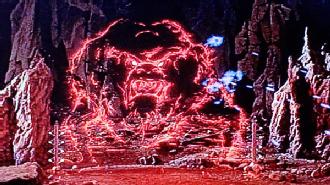 Later SF embraced these themes with a passion. The classic feature film Forbidden Planet (1956, dir. Wilcox) is a science-fictional retelling of William Shakespeare’s play The Tempest. While the original play reflects aspects of a castaway’s personality in the supernatural spirits that inhabit his island home, in Forbidden Planet these manifest instead as the product of advanced technology. The castaway character, Dr Morbius, discovers that an ancient race called the Krell vanished at the height of their technical achievement. As becomes clear, that was the result of a monster of their own creation - one that captured all the negative aspects of their own personalities and destroyed those responsible. Whether the "monster from the id" is sentient or can even be considered alive in any real sense is unclear. This example of a race destroyed by its creation is perhaps more analogous to the many moral tales regarding atomic weaponry than Frankenstein or Dr Moreau. However the extinction of the ancient Krell follows a similar pattern to other examples in which an entire race originates from experimentation, to the eventual deep regret of their elders.
Later SF embraced these themes with a passion. The classic feature film Forbidden Planet (1956, dir. Wilcox) is a science-fictional retelling of William Shakespeare’s play The Tempest. While the original play reflects aspects of a castaway’s personality in the supernatural spirits that inhabit his island home, in Forbidden Planet these manifest instead as the product of advanced technology. The castaway character, Dr Morbius, discovers that an ancient race called the Krell vanished at the height of their technical achievement. As becomes clear, that was the result of a monster of their own creation - one that captured all the negative aspects of their own personalities and destroyed those responsible. Whether the "monster from the id" is sentient or can even be considered alive in any real sense is unclear. This example of a race destroyed by its creation is perhaps more analogous to the many moral tales regarding atomic weaponry than Frankenstein or Dr Moreau. However the extinction of the ancient Krell follows a similar pattern to other examples in which an entire race originates from experimentation, to the eventual deep regret of their elders.
Such an accidental creation, albeit of a very different kind to that of the Krell, is the group known as the Reavers in television series Firefly (2002, written by Joss Whedon). The series follows a group of rebels and outcasts who crew a spaceship in a multi-star, multi-planet, human-inhabited system. In deep space, they encounter the Reavers, who were initially portrayed as a loosely defined set of spaceship crews driven insane by the empty vastness of space. However the sequel/conclusion film Serenity makes it clear that the Reavers owe their existence to an ill-advised chemical experiment carried out by an over-controlling government. The Reavers are mentally-twisted humans rather than a new species and their threat is constrained to space and the occasional remote output, but their antipathy to ‘normal’ humans and their potential for vast destruction is clear.
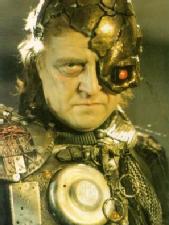 Genuinely novel species that do threaten their parent races are also common in science fiction. The robots in R.U.R., Simulants in Red Dwarf, humanoid Cylons in Battlestar Galactica and the Replicants in Blade Runner are all cloned, biologically engineered or otherwise manufactured through organic processes. In each case the artificial life form was manufactured to act as a servant or soldier race, and in each case it has achieved self-awareness, and often self-replication. In all these races their sentience is accompanied by desire for self-determination, and this results in rebellion against, or even genocide of, the parent human culture.
Genuinely novel species that do threaten their parent races are also common in science fiction. The robots in R.U.R., Simulants in Red Dwarf, humanoid Cylons in Battlestar Galactica and the Replicants in Blade Runner are all cloned, biologically engineered or otherwise manufactured through organic processes. In each case the artificial life form was manufactured to act as a servant or soldier race, and in each case it has achieved self-awareness, and often self-replication. In all these races their sentience is accompanied by desire for self-determination, and this results in rebellion against, or even genocide of, the parent human culture.
The back story of military SF television series Space: Above and Beyond (1995-1996) distinguishes itself by imagining that humanity would make the same mistake not once but twice in quick succession: first the Silicates were manufactured as servants and soldiers, based broadly on android technology, albeit virtually indistinguishable from organic humans, and then the In-Vitros were created. The latter are genetically-engineered organic human clones without added technology, but were used first as a labour source, and then as soldiers to fight the genocidally-rebelling Silicates. Unsurprisingly, they made unwilling and rebellious soldiers. In the television series, both Silicates and In-Vitros provide complicating factors in humanity’s battle against an entirely alien force attacking off-world colonies. The inclusion of an In-Vitro main character, and another whose family was killed by Silicates, provides a context in which the treatment of their offspring races by humans is considered and repeatedly found wanting.
Of course, as was the case with the semi-organic Silicates, often the rebelling offspring in SF are robot or AI species. While this topic is too large to cover here, examples include the original Cylons in Battlestar Galactica, Skynet in The Terminator and various androids, including those discussed in an earlier entry, as well as the android replacements encountered by the Enterprise in Star Trek (TV, 1966-9) episode “What are Little Girls Made of?”.
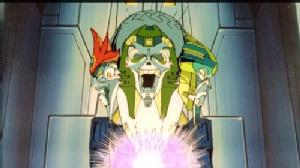 An interesting example in which the replacement of the creator race occurred so thoroughly and so long ago that it has effectively been forgotten can be found in the Transformers franchise. The backstory and mythology of this franchise is reimagined every few years, to tie in with a new media format and/or a new toy product release aimed at young children. However the fundamental premise invokes a race of long-lived, humanoid, artificial electro-mechanical life forms originating from the planet Cybertron. These are split into two factions, Autobots and Decepticons, whose civil war eventually reaches Earth. While Cybertronian reproduction is usually obscure, there is usually little evidence for designers, manufacturers or templates on whom the original Transformer was based. However a number of different imaginings of this premise have indeed invoked the existence of a creator race, known as the Quintessons, who first appeared in the Transformers movie of 1986 [1]. Curiously enough, these are often represented as non-humanoid, multi-faced and tentacled, so the humanoid body pattern for the Cybertronians was presumably utilitarian in origin rather than in imitation of their masters. Quintessons are also shown as as cruel and hard task masters. The original Transformers (as seen in the film and the third series of the television cartoon in 1986, known as Generation One) rebelled against the Quintessons, driving their surviving creators away and achieved their freedom, giving added weight to Autobot leader Optimus Prime’s assertion that “Freedom is the right of all sentient beings”. However in most of the Transformers franchise, the existence of the Quintessons and the creation of the first Cybertronians is lost in the mists of time and relegated to myth and legend.
An interesting example in which the replacement of the creator race occurred so thoroughly and so long ago that it has effectively been forgotten can be found in the Transformers franchise. The backstory and mythology of this franchise is reimagined every few years, to tie in with a new media format and/or a new toy product release aimed at young children. However the fundamental premise invokes a race of long-lived, humanoid, artificial electro-mechanical life forms originating from the planet Cybertron. These are split into two factions, Autobots and Decepticons, whose civil war eventually reaches Earth. While Cybertronian reproduction is usually obscure, there is usually little evidence for designers, manufacturers or templates on whom the original Transformer was based. However a number of different imaginings of this premise have indeed invoked the existence of a creator race, known as the Quintessons, who first appeared in the Transformers movie of 1986 [1]. Curiously enough, these are often represented as non-humanoid, multi-faced and tentacled, so the humanoid body pattern for the Cybertronians was presumably utilitarian in origin rather than in imitation of their masters. Quintessons are also shown as as cruel and hard task masters. The original Transformers (as seen in the film and the third series of the television cartoon in 1986, known as Generation One) rebelled against the Quintessons, driving their surviving creators away and achieved their freedom, giving added weight to Autobot leader Optimus Prime’s assertion that “Freedom is the right of all sentient beings”. However in most of the Transformers franchise, the existence of the Quintessons and the creation of the first Cybertronians is lost in the mists of time and relegated to myth and legend.
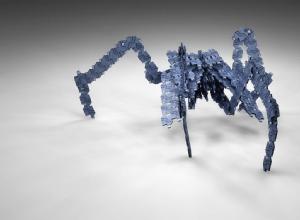 By contrast to the fully sentient and almost-too-human Transformers, SF also explorers examples of creator races destroyed by their very non-human products. The Daleks in Doctor Who are cyborgs whose organic elements are created by forced mutation and who turn on and destroy not only their creator Davros but also the whole Kaled race of which he was a part. Perhaps more extreme still is the case of the Replicators in the Stargate franchise (film 1994, TV 1997-2018). These are typically spider-like creatures made up of self-replicating electronic modules. Having been created as the play-things of a child-like android, itself created by a humanoid race, they replicated out of all control, wiped out the humanoids and went on to spread through the Milky Way and into another galaxy, destroying advanced races along the way. The replicators reproduce by consuming the raw material of spaceships or other infrastructure, reconstructing it into more replication modules. They are shown as akin to an insect hive and indeed sometimes feed raw materials to a “queen” for construction of new units. While individual units show little evidence for sentience, the drive to survive and reproduce manifests in clearly intelligent actions and decision making at a species level.
By contrast to the fully sentient and almost-too-human Transformers, SF also explorers examples of creator races destroyed by their very non-human products. The Daleks in Doctor Who are cyborgs whose organic elements are created by forced mutation and who turn on and destroy not only their creator Davros but also the whole Kaled race of which he was a part. Perhaps more extreme still is the case of the Replicators in the Stargate franchise (film 1994, TV 1997-2018). These are typically spider-like creatures made up of self-replicating electronic modules. Having been created as the play-things of a child-like android, itself created by a humanoid race, they replicated out of all control, wiped out the humanoids and went on to spread through the Milky Way and into another galaxy, destroying advanced races along the way. The replicators reproduce by consuming the raw material of spaceships or other infrastructure, reconstructing it into more replication modules. They are shown as akin to an insect hive and indeed sometimes feed raw materials to a “queen” for construction of new units. While individual units show little evidence for sentience, the drive to survive and reproduce manifests in clearly intelligent actions and decision making at a species level.
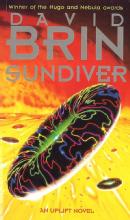 The majority of science fiction seems to presume that the creation of a new sentient race inevitably leads to conflict with the creators. An interesting counter example can be found in the Uplift series of novels by David Brin. Here species gain status by raising other life forms to sentience, and a Galaxy-wide culture of patronage exists in which many species remain subordinate to their creators for millions of years. While rebellions against the patron races do occur, they are by no means seen as inevitable or positive developments, and the rebel races inevitably themselves seek status by Uplifiting new sentient species, restoring the chain of patronage.
The majority of science fiction seems to presume that the creation of a new sentient race inevitably leads to conflict with the creators. An interesting counter example can be found in the Uplift series of novels by David Brin. Here species gain status by raising other life forms to sentience, and a Galaxy-wide culture of patronage exists in which many species remain subordinate to their creators for millions of years. While rebellions against the patron races do occur, they are by no means seen as inevitable or positive developments, and the rebel races inevitably themselves seek status by Uplifiting new sentient species, restoring the chain of patronage.
Also standing as counter examples are those narratives in which a new species arises from within humanity by natural means and replaces its predecessor through evolution rather than conflict - as seen in the many stories of Homo superior I've already discussed. While this does sometimes lead to conflict, such natural evolution stories usually lack the irony and bitterness that comes with the more dramatic destruction by one’s own creation.
The themes that run through these examples are, as always, rooted deeply in the cultures that made them.
One running theme explored in such narratives is the difficulty of recognising sentience and according rights to those initially deemed lesser. It is hard not to see in this a reflection of society’s difficulty reconciling our past treatment of other humans with the social and moral structures that permitted it. The rebellion of enslaved or servitor species in fiction often reflects deep cultural resonances regarding enslaved populations and, more recently, the fight for self-determination by peoples under an imperial or colonial administration.
These stories also draw deeply from the pathos and angst of intergenerational conflict. The cultural shifts which occur on timescales of decades in modern western culture are such that children rarely share the full range of experiences, expectations or mindset with their parents. As a result, conflict between cultural assumptions often manifest as conflict between generations, with both believing the other misunderstands and mistreats them. This is particularly true of cultures in which an expectation exists of respect, gratitude and support for the elder generation, regardless of their behaviour, available resources or their treatment of their younger descendants. Even within relatively static cultures, conflict between generations can arise from the conflicting needs of parents to nurture and protect, and offspring to develop, experiment and gain independence. The fact that such rifts occur within families heightens the tensions and emotional involvement of individuals in the conflict. Stories which describe the birth pangs of entire races pulling free from or even destroying their parent races are invoking the same parental angst as Shakespeare's King Lear lamenting the serpent-venom sharpness of betrayal by his previously-dutiful daughters.
However an interesting aspect of these science fictional narratives is that they also speak to a distrust of scientists and scientific progress. In many of the examples mentioned above, including all those involving biological engineering, androids and artificial intelligence, the rebelling race is the result of scientific experimentation, or the application of science without adequate moral oversight. The narratives question whether we can ever predict the results of advanced scientific experiments, or control their outcomes. As well as questioning the morality of enslavement, we might see an analogy for the anti-scientific backlash regarding nuclear weapons development in the apparent scientific hubris of Forbidden Planet’s Krell, while Stargate’s replicators mirror contemporary fears about AI, uncontrolled nanotechnology and its potential for catastrophic multiplication into an overwhelming “grey goo”.
By describing the deaths or even total destruction of humans (or Kaleds, Krell or others) at the hands of their own creations, science fiction is exploring this possible fate and warning the scientific community not to underestimate the risks they are taking. The development of any species, let alone one with self-awareness and sentience, is a heavy responsibility, and one too easily abused... with potentially disastrous consequences. Perhaps one day humanity will create our own replacements. Perhaps we will instead listen to the warning science fiction has to offer.
“Sharper than a Serpent’s Tooth”, Elizabeth Stanway. Cosmic Stories blog. 30th July 2023.
Notes:
[1] In a couple of other variants, the Quintessons are simply aliens the Transformers encounter, or are even themselves created by a rogue Cybertronian. Such are the complexities of the ever-evolving Transformers continuity. [Return to text]
This blog reflects the views of its creator, and not necessarily those of the University of Warwick. All images sourced from public websites online and used here for academic commentary.
